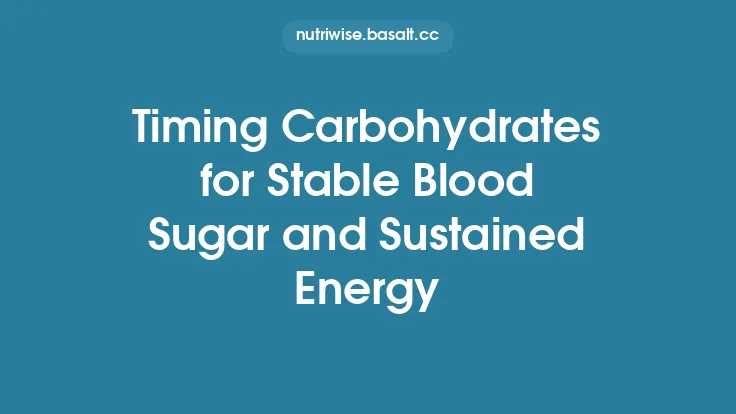When it comes to feeding the body, the “one‑size‑fits‑all” approach quickly falls apart. Even if you know the general recommendations for protein, carbs, and fats, the exact amount you need on any given day hinges on two dynamic variables: how much energy you expend and how efficiently your metabolism processes that energy. By understanding the physiological drivers behind total daily energy expenditure (TDEE) and the ways in which activity level and metabolic rate interact, you can fine‑tune portion sizes to match your personal energy demands—whether you’re training for a marathon, managing a sedentary desk job, or navigating the hormonal shifts of mid‑life.
1. The Foundations: Basal Metabolic Rate (BMR) and Total Daily Energy Expenditure (TDEE)
Basal Metabolic Rate (BMR) represents the calories your body needs to sustain basic physiological functions—breathing, circulation, cellular repair—while at complete rest. BMR is largely determined by:
| Factor | Influence on BMR |
|---|---|
| Lean Body Mass (LBM) | Each kilogram of LBM burns ~20–25 kcal/day at rest. |
| Age | BMR declines ~1–2 % per decade after age 30 due to loss of LBM and hormonal changes. |
| Sex | Men typically have higher BMR because they possess more LBM on average. |
| Genetics | Heritable variations can account for up to 10 % of BMR differences. |
| Hormonal Status | Thyroid hormones, cortisol, and sex hormones modulate metabolic rate. |
The most widely used equations for estimating BMR are the Mifflin‑St Jeor and Harris‑Benedict formulas. For example, the Mifflin‑St Jeor equation:
- Men: BMR = (10 × weight kg) + (6.25 × height cm) – (5 × age y) + 5
- Women: BMR = (10 × weight kg) + (6.25 × height cm) – (5 × age y) – 161
Once BMR is known, it is multiplied by an activity factor to yield TDEE, the total calories burned in a 24‑hour period.
2. Activity Factors: From Sedentary to Elite
Activity factors translate the qualitative description of daily movement into a quantitative multiplier. The classic scale is:
| Activity Level | Description | Multiplier |
|---|---|---|
| Sedentary | Little or no exercise, desk‑bound work | 1.2 |
| Lightly active | Light exercise 1–3 days/week (e.g., casual walking) | 1.375 |
| Moderately active | Moderate exercise 3–5 days/week (e.g., jogging, cycling) | 1.55 |
| Very active | Intense exercise 6–7 days/week (e.g., high‑intensity training) | 1.725 |
| Extra active | Professional athletes, physically demanding jobs | 1.9 |
These multipliers are averages; individual variation can be substantial. For precise adjustment, many athletes track non‑exercise activity thermogenesis (NEAT)—the calories burned through fidgeting, standing, and daily chores—using wearable devices that estimate steps, heart rate, and metabolic equivalents (METs). Adding NEAT to structured exercise yields a more accurate TDEE.
3. Metabolic Rate Modifiers: Hormones, Body Composition, and Adaptive Thermogenesis
Even with a solid BMR estimate, several physiological mechanisms can shift the actual metabolic rate up or down:
3.1 Hormonal Influences
- Thyroid Hormones (T3/T4): Hyperthyroidism can increase BMR by 10–20 %; hypothyroidism can reduce it similarly.
- Insulin Sensitivity: Chronic high insulin levels (e.g., from frequent high‑glycemic meals) can blunt lipolysis, subtly lowering resting energy expenditure.
- Sex Hormones: Estrogen tends to preserve LBM, while testosterone directly stimulates protein synthesis and muscle mass, both raising BMR.
3.2 Body Composition Shifts
- Lean Mass Gains: Adding 1 kg of muscle can raise BMR by ~20–25 kcal/day, but the effect is modest compared to the caloric cost of building that muscle.
- Fat Mass: Adipose tissue is metabolically active (≈4–6 kcal/kg/day) but contributes far less to BMR than muscle.
3.3 Adaptive Thermogenesis
When caloric intake deviates markedly from TDEE, the body can adjust its energy expenditure to protect homeostasis:
- Negative Energy Balance: Metabolic rate may drop 5–15 % (the “starvation response”), making further calorie reduction less effective.
- Positive Energy Balance: Metabolic rate can rise modestly (≈5 %) due to increased diet‑induced thermogenesis and the cost of storing excess nutrients.
Understanding these modifiers helps you anticipate why a static portion plan may feel “off” during periods of hormonal change (e.g., menstrual cycle, menopause) or after a training block that dramatically alters body composition.
4. Translating Energy Needs into Portion Sizes
Once TDEE is established, the next step is converting calories into practical food portions. This process involves three layers:
- Macro Distribution – Decide what percentage of calories will come from carbohydrates, proteins, and fats based on activity type.
- Energy Density – Recognize that foods differ in calories per gram; high‑density foods (nuts, oils) require smaller portions for the same caloric load.
- Portion Scaling – Adjust the gram weight of each food group proportionally to meet the target calorie count.
4.1 Macro Distribution by Activity Type
| Activity | Typical Macro Split* | Rationale |
|---|---|---|
| Endurance (≥ 90 min) | 55 % carbs, 15 % protein, 30 % fat | Carbs replenish glycogen; modest protein supports repair. |
| Strength/Hypertrophy | 40 % carbs, 30 % protein, 30 % fat | Higher protein supports muscle protein synthesis; carbs fuel lifts. |
| Mixed (moderate cardio + strength) | 45 % carbs, 25 % protein, 30 % fat | Balanced to support both glycogen and repair. |
| Low‑Intensity/Recovery Days | 35 % carbs, 30 % protein, 35 % fat | Reduced carb demand; higher fat provides sustained energy. |
\*These are starting points; individual tolerance and goals may shift the ratios.
4.2 Energy Density Primer
| Food Category | Approx. kcal/100 g | Portion Guidance |
|---|---|---|
| Leafy greens | 15–25 | Large volumes (e.g., 2 cups) for minimal calories. |
| Starchy vegetables | 70–90 | Moderate servings (½ cup cooked). |
| Whole grains | 340–380 | Standard serving (½ cup cooked). |
| Lean proteins | 120–150 | 100 g (≈3.5 oz) cooked weight. |
| Nuts & seeds | 560–620 | 30 g (≈1 oz) as a snack or topping. |
| Oils | 880 | 1 tsp (≈5 ml) ≈ 40 kcal. |
By pairing high‑density foods with low‑density ones on the plate, you can meet caloric targets without feeling overly full or under‑fed.
4.3 Practical Portion Scaling Workflow
- Calculate Target Calories – TDEE ± desired surplus/deficit (e.g., +250 kcal for muscle gain).
- Assign Macro Calories – Multiply total calories by macro percentages.
- Convert to Grams – Divide macro calories by their caloric values (protein = 4 kcal/g, carbs = 4 kcal/g, fat = 9 kcal/g).
- Select Food Sources – Choose foods that fit your dietary preferences and have known energy densities.
- Determine Gram Weights – Use the energy density table to translate macro grams into food portions. For example, 150 g of cooked quinoa (≈120 kcal/100 g) provides ~180 kcal, covering ~45 g of carbs.
5. Adjusting Portions Across Training Cycles
Athletes and active individuals rarely maintain a single activity level year‑round. Periodization—systematically varying training intensity and volume—necessitates corresponding shifts in nutrition.
5.1 Macro Cycling
- High‑Volume Weeks (e.g., 5–6 days of long runs): Increase carbohydrate portions by 10–20 % while keeping protein constant.
- Taper Weeks (reduced volume before competition): Reduce carbs modestly, maintain protein, and slightly increase healthy fats to preserve energy density without excess glycogen storage.
- Strength‑Focused Blocks: Elevate protein portions (up to 2.2 g/kg body weight) and keep carbs moderate.
5.2 Portion Timing
- Pre‑Exercise: Prioritize easily digestible carbs (e.g., 30–60 g) 30–60 minutes before activity to top off glycogen.
- Post‑Exercise: Aim for a 3:1 carb‑to‑protein ratio within 2 hours of finishing a session to accelerate glycogen replenishment and stimulate muscle repair.
- Rest Days: Shift the bulk of calories to fats and proteins, reducing carb portions to align with lower glycogen demand.
5.3 Monitoring and Fine‑Tuning
- Body Weight Trends: A stable weight (±0.5 kg) over 2–3 weeks suggests portion sizes are matching energy expenditure.
- Performance Markers: Diminished endurance or strength output can signal insufficient carbohydrate portions.
- Subjective Energy Levels: Persistent fatigue, irritability, or poor sleep may indicate a mismatch between metabolic needs and portion sizes.
6. Special Populations: Age, Sex, and Hormonal Considerations
6.1 Older Adults (≥ 65 years)
- Reduced BMR: Approximately 5–10 % lower than younger counterparts.
- Higher Protein Needs: 1.2–1.5 g/kg to counteract sarcopenia.
- Portion Adjustment: Slightly lower total calories but maintain or increase protein portions; incorporate nutrient‑dense foods (e.g., legumes, dairy) to meet micronutrient requirements.
6.2 Women Across the Menstrual Cycle
- Follicular Phase (Days 1‑14): Slightly lower resting metabolic rate; modest carb portions suffice.
- Luteal Phase (Days 15‑28): ↑ Thermogenesis (~2–3 % rise) and ↑ protein turnover; modestly increase protein and carbohydrate portions to offset higher energy demand.
6.3 Individuals with Thyroid Dysfunction
- Hypothyroidism: May require a 5–10 % increase in total calories to offset reduced BMR; focus on iodine‑rich foods and adequate protein.
- Hyperthyroidism: May need a 5–10 % reduction in portion sizes; monitor for unintended weight loss and ensure sufficient micronutrient intake.
7. Tools for Ongoing Portion Adjustment
While the article avoids recommending specific measuring devices, it is useful to understand the data sources that can inform portion tweaks:
- Wearable Metabolic Trackers: Provide daily estimates of TDEE based on heart rate variability, movement, and personal profile.
- Food Logging Apps: Allow you to input actual food intake and compare against calculated macro targets, highlighting over‑ or under‑portioned meals.
- Periodic BMR Re‑assessment: Every 4–6 weeks, recalculate BMR if body weight or composition has changed by > 2 kg, as LBM shifts will affect basal needs.
8. Putting It All Together: A Sample Calculation
Scenario: A 30‑year‑old male, 78 kg, 180 cm, training for a half‑marathon (moderately active, 5 days/week of 60‑minute runs).
- BMR (Mifflin‑St Jeor):
(10 × 78) + (6.25 × 180) – (5 × 30) + 5 = 780 + 1125 – 150 + 5 = 1760 kcal.
- TDEE:
1760 kcal × 1.55 (moderately active) = 2728 kcal.
- Macro Split (Endurance): 55 % carbs, 15 % protein, 30 % fat.
- Carbs: 0.55 × 2728 ≈ 1500 kcal → 1500 / 4 = 375 g.
- Protein: 0.15 × 2728 ≈ 410 kcal → 410 / 4 = 102 g.
- Fat: 0.30 × 2728 ≈ 818 kcal → 818 / 9 ≈ 91 g.
- Portion Translation (example foods):
- Carbs: 200 g cooked quinoa (≈240 kcal) + 150 g sweet potato (≈135 kcal) + 2 cups mixed fruit (≈200 kcal) = 575 kcal (≈144 g carbs). Add a small banana (≈27 g carbs) to reach target.
- Protein: 150 g grilled chicken breast (≈165 kcal, 31 g protein) + 100 g Greek yogurt (≈59 kcal, 10 g protein) + 30 g whey isolate (≈120 kcal, 24 g protein) = 344 kcal (≈65 g protein). Supplement with 30 g almonds (≈174 kcal, 6 g protein) and a boiled egg (≈78 kcal, 6 g protein) to meet 102 g.
- Fats: 2 tsp olive oil (≈80 kcal) used for cooking, 30 g avocado (≈48 kcal), and the 30 g almonds above (≈14 g fat) complete the 91 g target.
- Resulting Daily Portion List:
- 200 g cooked quinoa
- 150 g sweet potato
- 2 cups mixed fruit
- 1 small banana
- 150 g grilled chicken breast
- 100 g Greek yogurt
- 30 g whey isolate (mixed in water)
- 1 boiled egg
- 30 g almonds
- 2 tsp olive oil
- 30 g avocado
This example demonstrates how a calculated energy need can be broken down into concrete, food‑specific portions that align with activity level and metabolic rate.
9. Frequently Overlooked Adjustments
- Thermic Effect of Food (TEF): Protein has the highest TEF (~20–30 % of its calories), meaning a diet richer in protein slightly raises total energy expenditure. When increasing protein portions, you may need to modestly adjust total calories upward to avoid an unintended deficit.
- Hydration and Electrolytes: Fluid balance influences metabolic rate; dehydration can reduce BMR by up to 5 %. Ensure water intake matches sweat losses, especially on high‑intensity days.
- Sleep Quality: Chronic sleep restriction can lower leptin and raise ghrelin, subtly increasing appetite and reducing resting metabolic rate. While not a direct portion‑size issue, it underscores the need for holistic lifestyle alignment.
10. Summary Checklist for Dynamic Portion Adjustment
- [ ] Calculate BMR using a validated equation and update when weight or body composition changes.
- [ ] Select the appropriate activity factor based on daily training volume and NEAT.
- [ ] Determine TDEE and decide on any intentional surplus or deficit.
- [ ] Choose a macro split that matches the primary type of activity (endurance, strength, mixed).
- [ ] Convert macro targets to gram amounts and then to food‑specific portions using energy density data.
- [ ] Adjust portions at the start of each training block (volume, intensity, taper) and after major body composition changes.
- [ ] Monitor performance, weight, and subjective energy to fine‑tune portion sizes.
- [ ] Re‑evaluate BMR and TDEE every 4–6 weeks or after significant lifestyle shifts (e.g., new job, hormonal changes).
By grounding portion decisions in the science of metabolism and activity level, you create a flexible, evidence‑based framework that can adapt as your body and goals evolve—ensuring you consistently fuel appropriately without relying on vague “eyeballing” or generic portion rules.





